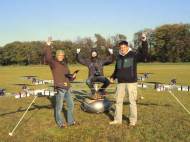e-volo electric multicopter performed its first manned flight
 In our previous articles we wrote about quadricopters used in research regarding swarm algorithms and entertainment, but a group of people from Germany took the application of these electrically charged flying machines a step further. They created e-volo electric multicopter – a sixteen propeller flying vehicle which completed its first manned flight at the end of October 2011.
In our previous articles we wrote about quadricopters used in research regarding swarm algorithms and entertainment, but a group of people from Germany took the application of these electrically charged flying machines a step further. They created e-volo electric multicopter – a sixteen propeller flying vehicle which completed its first manned flight at the end of October 2011.
Piloted by Thomas Senkel, who developed the concept as a graduate physicist and later came up with complete mechanical and electrical construction of the e-volo multicopter, the vehicle flew for one minute and 30 seconds. Although it doesn’t sound impressive, it is a start with a lot of room for improvement. Remember, the longest first flight performed by Wilbur Wright on December 17th 1903 lasted only 59 seconds.
The vehicle weights only 80kg (176 pounds) including batteries, and its propellers create the full lift and balance the vehicle once it is airborne by applying independent speed control of the motors. Flight time can last between ten to thirty minutes, depending on the payload and the capacity of the lithium batteries. This electrically driven vehicle is less noisy than helicopters, and it could be more cost efficient. According to its developers, a one-hour flight would cost less than $10 (6 Euro) for needed electricity.
Aside being quieter and more affordable than helicopters, e-volo multicopter developers pointed out that the vehicle’s the simplicity of its engineered construction without complicated mechanics and its redundant engines have less parts which are also easier to maintain. In case of motor failure on some of its propellers, the vehicle is capable to land safely even if up to four of its sixteen motors fail. In difference to other helicopters or other multi-rotors, e-volo multicopter design allows it to use a safety parachute, as there are no propellers blocking the deployment area above.
The automatic attitude and directional control are performed by multiple separate and mutually monitoring onboard computers. A simple joystick allows the pilot to control the aircraft via a fly-by-wire system. Developed by Stephan Wolf, its control firmware can be integrated with a sophisticated integrated GPS system or obstacle detection, thus enabling automated flight for predetermined points on a 3D map. The software and simplified mechanics allow the pilot to pay little attention to minimum speed, stall, gas mixture control, pitch control or one of many other things that make conventional flight as challenging as it is.
Longer flight times are achievable, with higher energy amounts and lower payloads. Advances in battery storage technology could increase the current average flight time of 20 minutes to an hour or more. Its developers are also considering a hybrid drive, in which a conventional internal combustion engine generates the necessary electrical power.
The current single seat vehicle has a great potential to be used as air sports equipment or in the leisure sector. Once it is fully developed and its drive issues are resolved, the folks from e-volo plan to develop a multi-seater which could be used in various applications such as sightseeing flights, air ambulance, or air taxi.









Leave your response!